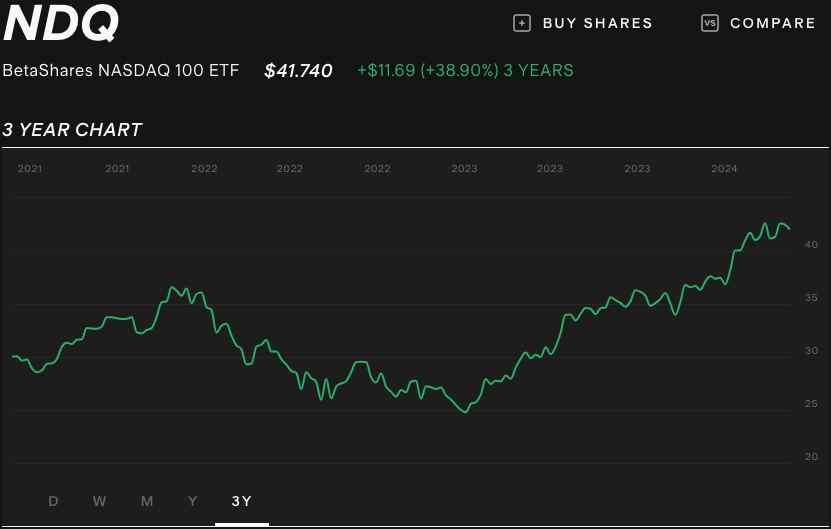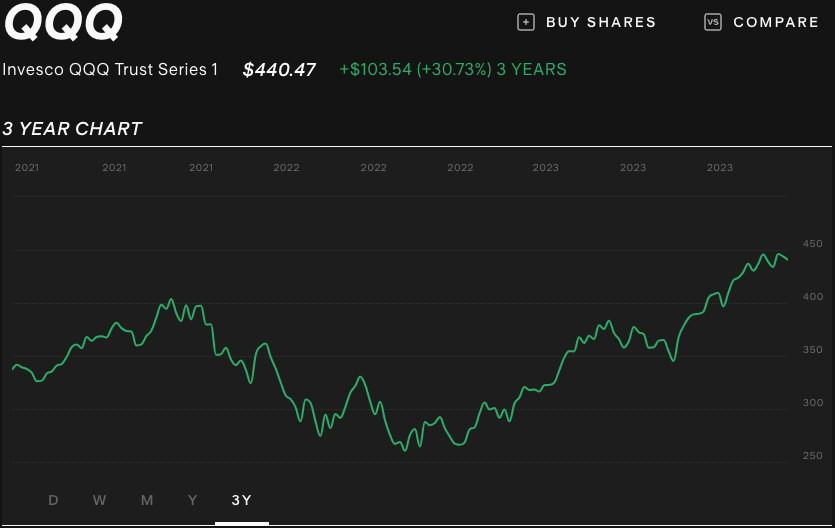
How to invest in Nasdaq from Australia [2024]
The Nasdaq is one of the most recognised stock exchanges in the world. Home to some of the biggest players in tech and innovation, check out how to access and invest in the Nasdaq from Australia.
This article focuses on how to buy specific securities, however, it is not a recommendation to invest in them and should not be taken as financial advice. Do your own research and make your own decisions, or even consider getting advice from a licensed financial adviser before investing.
What is the Nasdaq?
The National Association of Securities Dealers Automated Quotations, or Nasdaq, is one of the largest stock exchanges in the world. The exchange is quite technology-focused and houses some of the biggest tech companies including Tesla Inc. ($TSLA), Apple Inc. ($AAPL), Microsoft ($MSFT) and more.
What is the Nasdaq 100?
The Nasdaq 100 index comprises 100 of the largest companies listed on the Nasdaq stock exchange, based on their market capitalisation.
The index is reviewed yearly and reflects a diverse range of industries and sectors including biotechnology, computer software, hardware and telecommunications.
What stocks are in the Nasdaq 100?
As mentioned, the Nasdaq 100 is adjusted on an annual basis. Here are the top 10 weighted components of the index as per the Nasdaq 100 fact sheet:
Holding | Ticker | Sector | Weight (%) |
|---|---|---|---|
Microsoft Corp | Technology | 8.75% | |
Apple Inc. | Technology | 7.41% | |
NVIDIA Corporation | Technology | 6.32% | |
Amazon.com Inc | Consumer Cyclical | 5.25% | |
Meta Platforms Inc. | Communication Services | 4.76% | |
Broadcom Inc. | Technology | 4.44% | |
Alphabet Inc. - Class A Shares | Communication Services | 2.49% | |
Alphabet Inc. - Class C Shares | Communication Services | 2.42% | |
Tesla Inc. | Technology | 2.37% | |
Costco Wholesale | Consumer staples | 2.35% |
Information as of 28 March 2024.
How to invest in Nasdaq from Australia
One of the simplest ways for Australian investors to gain exposure to Nasdaq is by searching for exchange-traded funds (ETFs) that track a Nasdaq index on the Australian Securities Exchange (ASX) or a U.S. stock exchange.
You’ll need access to a share trading account and funds for your initial investment. The right share trading platform should align with your investing strategy which includes the markets and the features that complement it.
If you open an account with Stake you can invest in Australian and U.S. securities, which means you can access Nasdaq ETFs across both markets. Read our guide to learn more about investing in ETFs as a beginner.
✅ Discover these Nasdaq ETFs on Wall St→
Steps on how to buy Nasdaq in Australia
1. Open a stock investing account
To buy a Nasdaq ETF, you'll need to sign up with an investing platform that has access to a range of ASX and U.S.-listed securities. For instance, Stake has access to over 12,000 Aussie and U.S. securities, including individual Nasdaq shares and Nasdaq-exposed ETFs.
2. Fund your account
Once you’ve signed up for an investing account and passed any required identification checks, it’s time to make a deposit. Most platforms will offer a variety of methods to deposit funds. For instance, Stake supports deposits via Google Pay, Apple Pay, credit/debit card or direct bank transfer.
3. Search for an ETF that tracks a Nasdaq index
After funding your account, it’s time to start researching and to seek out the Nasdaq investment opportunities that appeal to you. Many online resources are available to help guide you on where to start searching.
You could also take inspiration from Stake’s very own deep dive series, ‘Under The Spotlight’, a weekly examination of a U.S. or ASX-listed stock. Not only will you get the skinny on Nasdaq-listed companies, but you’ll also get to discover and learn about a wide range of stocks listed on the ASX and New York Stock Exchange.
As with any investment, take the time to do your research and ensure it is suitable for your circumstances and investment strategy.
4. Choose an order type and buy the asset
After finding the Nasdaq ETF or stock that appeals to you, it’s time to place a buy order. You can choose to place a limit, market or stop order on the market of your choosing. Each order type has different parameters that can play a role in your decision-making.
You can learn more about the different order types here.
5. Monitor your investment
The next step is to keep a close eye on your new investment and monitor for any changes or fluctuations. It’s important to remember that multiple factors can impact the stock market in the short term or long term, it’s important to contextualise any fluctuations or changes and conduct due diligence in understanding them.
If you’re considering investing over the long term, you may consider strategies popularised by other investors. One popular strategy is dollar cost averaging which is employed by certain investors who believe it mitigates long-term risk by investing a set amount in regular increments.
Making a habit of logging in to your investing platform regularly allows you to keep track of your investments effectively.

Here are 4 ways how you can invest in the Nasdaq
Let’s break down a few of the main avenues for investing in the Nasdaq.
Individual stocks
If a particular Nasdaq-listed stock catches your eye, you might consider purchasing individual or fractional shares in that company.
There are additional considerations if you’re looking to trade shares including individual share prices and – in the case of international shares – currency conversion or FX fees that may be applicable.
Keep in mind, buying individual shares will only provide exposure to single entities which can increase overall risk, it’s always advisable to consider diversifying your portfolio holdings to spread risk more effectively.
Exchange-traded funds
Some investors utilise exchange-traded funds (ETFs) to gain simple and broad exposure to Nasdaq indexes. Some ETFs cater to sub-sections of the Nasdaq such as the Nasdaq 100, while others can cover the broader Nasdaq composite index.
There are also Nasdaq ETFs that are more suited for sophisticated investors. These include leveraged ETFs and inverse ETFs which carry additional risk.
Check out some of the top index funds available to invest in on Stake.
CFDs
Another pathway to invest in the Nasdaq is through contracts for difference, otherwise known as CFD trading.
Trading CFDs is not the same as purchasing shares on traditional trading platforms as you’re not owning the index or shares. Instead, you’re trading on the futures market and making investments based on future prices.
It should be noted, CFD trading is one of the riskiest methods of gaining exposure to the Nasdaq and should only be considered by sophisticated and experienced investors. Trading CFDs will also typically require advanced trading tools and an incredibly deep understanding of market sentiment.
Superannuation
Another common method for accessing global markets is via your superannuation. Some providers will give you the choice of where to invest your super, which could include shares and ETFs on the Nasdaq.
You’ll have to check with your superannuation fund on whether this is an option for you. Be sure also to check your provider’s target market determination (TMD) document to determine your suitability.
Another option could be to invest in the Nasdaq using a self-managed super fund (SMSF). This option allows you to make independent investments on a trading platform using your superannuation.
Of course, self-managed funds may not be suitable for your circumstances, it’s best to consult professional advice from a financial planner before investing with your super.
What Australian ETF tracks the Nasdaq 100 index?
The following Australian ETFs (available on the ASX) seek to track the Nasdaq 100 index.
BetaShares NASDAQ 100 ETF ($NDQ)
One of the more well-known index funds with exposure to the Nasdaq 100 is the BetaShares NASDAQ 100 ETF ($NDQ) which seeks to track the performance of the underlying index. The ETF contains the 100 largest non-financial companies listed on the exchange weighted proportionately by their market capitalisation.

BetaShares Nasdaq 100 Equal Weight ETF ($QNDQ)
A relatively new ETF to launch on the ASX is the BetaShares Nasdaq 100 Equal Weight ETF ($QNDQ). Launched in February 2024, this ETF tracks the same companies as $NDQ, but with the caveat of equally weighted holdings. This means, instead of determining the proportional weightings on market capitalisation, all 100 companies comprise an equal weight in the fund.
Global X US 100 ETF ($N100)
Another ASX-listed security tracking the index is the Global X US 100 ETF ($N100). Similar to $NDQ, the ETF contains the 100 largest non-financial companies on the exchange proportionally weighted by market cap.
When determining index funds with similar holdings, it’s important to consider other factors surrounding the security including share prices and how actively traded they are.
What U.S. ETFs track the Nasdaq 100 index?
The following U.S. ETFs seek to track the Nasdaq 100 index.
Invesco QQQ Trust Series 1 ETF ($QQQ)
Listed in 1999, the Invesco QQQ Trust Series 1 ETF ($QQQ) tracks the Nasdaq 100 index. The 100 largest non-financial companies on the index are large and mega-cap companies across industries including telecommunications, computer hardware, software and more.

Invesco NASDAQ 100 ETF ($QQQM)
Similar to $QQQ, the Invesco NASDAQ 100 ETF ($QQQM) tracks the Nasdaq 100 index. Introduced as a more cost-efficient variant in 2020, the fund also reinvests dividends and has a smaller share price than $QQQ.
Direxion Nasdaq 100 Equal Weighted Index Shares ($QQQE)
Launched in 2012, the Direxion Nasdaq 100 Equal Weighted Index Shares ETF ($QQQE) is a passively managed index fund that seeks to track the Nasdaq 100. Holdings are not proportionally weighted by market cap and are instead equally weighted.
Pros and cons of investing in the Nasdaq
Let's look at the pros and cons of investing in the Nasdaq index:
Pros | Cons |
|---|---|
Access: Investing in external stock exchanges yields access to some of the world’s biggest companies that are not listed on local exchanges. | Market fluctuation: Like all financial markets, there is always the potential risk of price fluctuation and periods of volatility which may result in capital losses. |
Higher liquidity: The U.S. market is one of the most liquid in the world, boasting an impressively high daily trade volume. | Potential sector breakdown: There are many Nasdaq-listed companies in the tech sector. In the event of a sector breakdown or downturn, there may be an elevated risk of capital loss if investing is focused on one sector. |
Exposure to innovation: Some of the world’s most innovative companies are listed on the exchange including household names like Tesla ($TSLA), Google ($GOOG) and Apple ($AAPL). | Foreign exchange fees: An important consideration for investing in international markets is the potential costs to transfer funds into foreign currencies. |
Nasdaq FAQs
Is the Nasdaq a good investment?
The exchange comprises a large number of tech and consumer discretionary companies, two sectors that have seen sustained growth over the last 20 years.
Companies on the exchange have also seen some intense volatility during that period which may increase risk for some investors.
Determining whether the Nasdaq is a good investment or not will depend heavily on your own circumstances, financial situation and risk tolerance. It’s always advisable to seek professional advice before you start investing.
Is the Nasdaq 100 the same as the Nasdaq Composite?
The Nasdaq Composite tracks over 3,000 companies listed on the stock exchange whereas the Nasdaq 100 index only tracks the top 100 non-financial companies on the exchange.
What time does Nasdaq open in Australia?
The Nasdaq exchange is open from 9:30 am - 4:00 pm (EST/EDT), Monday to Friday.
For Australians, the Nasdaq is open between 11:30 pm - 6:00 am (AEST), Monday to Friday.
With Extended Hours trading active you’ll also have an additional 9.5 hours each trading day to access the Nasdaq with pre-market (6:00 pm - 11:30 pm AEST) and after hours trading (6:00 am - 10:00 am AEST) sessions.
What is the difference between the Nasdaq 100 and the S&P 500?
There are typically three major indexes that comprise the U.S. market, the S&P 500, the Dow Jones Industrial Average and the Nasdaq Composite which contains the Nasdaq 100.
The S&P 500 measures the top 500 largest U.S.-listed companies by market cap which can include companies listed across the U.S. exchanges. The Dow Jones Industrial Average measures only 30 U.S. companies that satisfy blue-chip criteria such as market capitalisation, consistent growth and long-term interest from investors.
Comparatively, the Nasdaq 100 index only tracks the top 100 non-financial companies listed on the Nasdaq stock exchange.
🎓 Learn more: Get to know the S&P 500→

This does not constitute financial product advice nor a recommendation to invest in the securities listed. Past performance is not a reliable indicator of future performance. When you invest, your capital is at risk. You should consider your own investment objectives, financial situation, particular needs. The value of your investments can go down as well as up and you may receive back less than your original investment. As always, do your own research and consider seeking appropriate financial advice before investing.
Any advice provided by Stake is of general nature only and does not take into account your specific circumstances. Trading and volume data from the Stake investing platform for reference purposes only, the investment choices of others may not be appropriate for your needs and is not a reliable indicator of performance.

Megan is a markets analyst at Stake, with 7 years of experience in the world of investing and a Master’s degree in Business and Economics from The University of Sydney Business School. Megan has extensive knowledge of the UK markets, working as an analyst at ARCH Emerging Markets - a UK investment advisory platform focused on private equity. Previously she also worked as an analyst at Australian robo advisor Stockspot, where she researched ASX listed equities and helped construct the company's portfolios.

